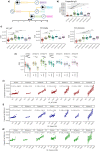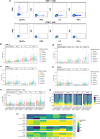SARS-CoV-2 humoral and cellular immunity following different combinations of vaccination and breakthrough infection
- PMID: 36732523
- PMCID: PMC9894521
- DOI: 10.1038/s41467-023-36250-4
SARS-CoV-2 humoral and cellular immunity following different combinations of vaccination and breakthrough infection
Abstract
The elicited anti-SARS-CoV-2 immunity is becoming increasingly complex with individuals receiving a different number of vaccine doses paired with or without recovery from breakthrough infections with different variants. Here we analyze the immunity of individuals that initially received two doses of mRNA vaccine and either received a booster vaccination, recovered from a breakthrough infection, or both. Our data suggest that two vaccine doses and delta breakthrough infection or three vaccine doses and optionally omicron or delta infection provide better B cell immunity than the initial two doses of mRNA vaccine with or without alpha breakthrough infection. A particularly potent B cell response against the currently circulating omicron variant (B. 1.1.529) was observed for thrice vaccinated individuals with omicron breakthrough infection; a 46-fold increase in plasma neutralization compared to two vaccine doses (p < 0.0001). The T cell response after two vaccine doses is not significantly influenced by additional antigen exposures. Of note, individuals with hybrid immunity show better correlated adaptive immune responses compared to those only vaccinated. Taken together, our data provide a detailed insight into SARS-CoV-2 immunity following different antigen exposure scenarios.
© 2023. The Author(s).
Conflict of interest statement
The authors declare no competing interests. The idea, the plan, the concept, the protocol, the conduct, the data analysis, and the writing of the manuscript of this study were independent of any third parties, including the funding agency.
Figures





References
Publication types
MeSH terms
Substances
Supplementary concepts
LinkOut - more resources
Full Text Sources
Medical
Miscellaneous

